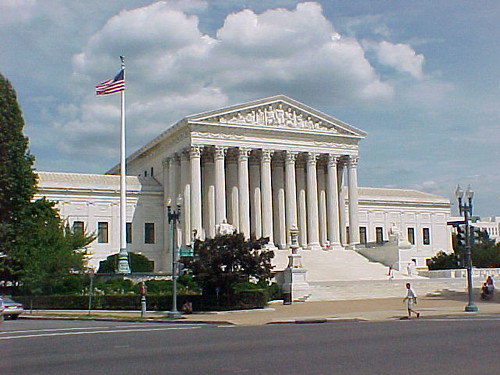Key Takeaways:
- The Supreme Court paused a decision to release foreign aid.
- President Trump asked judges to freeze funding until court review.
- About $5 billion helps fight hunger, HIV, and support refugees.
- The freeze could delay vaccines, schooling, and crime prevention.
- The legal battle will decide who controls government spending.
Foreign Aid Freeze Explained
The Supreme Court stepped in to stop a lower court order. That order would have let the government spend billions in foreign aid. Instead, the court said the freeze stays until judges sort out the case. This decision leaves many wondering what will happen next.
Why Did the Supreme Court Act?
A judge ruled last week that only Congress can decide if the government can use the money. The judge argued that the president cannot hold on to funds that Congress already approved. However, President Trump asked the highest court to block that ruling in an emergency request. He wrote that this case asks a huge question: can the courts even challenge the executive branch’s choice not to spend approved money?
The Court of Appeals for the D.C. Circuit had already thrown out the first judge’s order. Yet, it did not rule on the overall lawsuit. It simply said the lower court acted too quickly. Therefore, the money stayed frozen. Now, the Supreme Court has also paused spending until the full case plays out.
What Does the Aid Do?
The nearly $5 billion in foreign aid helps people around the world in many ways:
Fighting Hunger
The funds support programs that feed families in crisis zones. They supply food shipments and crop seeds.
Combating HIV-AIDS
Money goes toward treatments, testing, and prevention programs. It helps save lives in high-risk areas.
Supporting Refugees
Refugee camps need shelter, clean water, and medical care. The aid keeps these essential services running.
Educating Women and Girls
Programs build schools, train teachers, and supply books. They open doors to brighter futures for girls.
Battling Illicit Drugs
Funds help stop drug trafficking and addiction. They back law enforcement and community education.
Without this foreign aid, millions could lose their lifeline. Food shortages could worsen. Health services might shut down. Girls could miss school for years.
How Will People Be Affected?
In parts of Africa, Latin America, and Asia, aid dollars buy vaccines. They also pay doctors and nurses. Aid workers use the money to set up mobile clinics in remote areas. If the funds remain frozen, these clinics could close. People might miss treatments for preventable illnesses.
In refugee camps, families live in tents or makeshift shelters. Aid pays for water, sanitation, and emergency care. A sudden cut could force camps to ration water and medicine. Children could go hungry and fall sick without proper care.
In areas battling drug cartels, aid supports rehabilitation centers. It funds outreach that helps addicts find treatment. Without funding, these centers might shut doors. Law enforcement would lose training programs and equipment. Community groups that teach drug prevention would shut down.
Furthermore, many women and girls rely on schooling programs paid for by foreign aid. These schools often teach basic literacy, health, and job skills. Cutting funds stalls progress toward gender equality. Girls may stay home instead of attending class. That outcome hurts entire communities over time.
What Comes Next for Foreign Aid?
The court’s decision buys time but doesn’t answer the main question. Judges must decide if the president can refuse to spend money Congress approved. They will weigh constitutional powers of both the legislative and executive branches.
Meanwhile, foreign governments and aid organizations wait for clarity. They plan budgets around U.S. aid pledges. Delays force them to pause or scale back critical projects. That uncertainty can drive up costs once funding resumes.
Congress may also step in. Lawmakers could pass new rules that spell out how and when the president can withhold money. Or they might tie foreign aid to specific conditions on human rights or trade.
In the end, the case may reach a full Supreme Court review. That process can take months. During that time, billions will remain on hold. Impact reports from aid groups will pour in, showing how delays hurt real people.
If courts side with the president, the executive branch may gain more control over spending. If they side with Congress, lawmakers will hold the purse strings tighter. Either way, this case will set a major precedent.
Staying Informed as the Case Moves Forward
For now, aid agencies will issue updates on project status. They may request emergency funds from other donors. Journalists and watchdog groups will track numbers on hunger, disease, and schooling.
Citizens in the U.S. will also watch closely. Some may write to their representatives to demand action. Others might join advocacy groups urging Congress to clarify who controls spending.
In the weeks ahead, we will learn more about court dates and hearings. Each step will bring fresh insights into the separation of powers. We will also see stories from communities on hold, waiting for help to arrive.
Frequently Asked Questions
What is foreign aid?
Foreign aid is financial or material help that one country gives to others. It supports health, hunger relief, education, and disaster recovery.
Why did the Supreme Court freeze the funding?
The court froze funding to keep the status quo while judges decide if the president can withhold approved money.
How does the freeze affect people abroad?
Aid projects for food, medicine, and schooling face delays or cuts. That hurts vulnerable communities waiting on vital services.
What happens next in the legal case?
Judges will review arguments on executive spending powers. The full Supreme Court may eventually weigh in.

